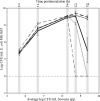Role of quorum sensing and antimicrobial component production by Serratia plymuthica in formation of biofilms, including mixed biofilms with Escherichia coli
- PMID: 16997989
- PMCID: PMC1636202
- DOI: 10.1128/AEM.01708-06
Role of quorum sensing and antimicrobial component production by Serratia plymuthica in formation of biofilms, including mixed biofilms with Escherichia coli
Abstract
We have previously characterized the N-acyl-l-homoserine lactone-based quorum-sensing system of the biofilm isolate Serratia plymuthica RVH1. Here we investigated the role of quorum sensing and of quorum-sensing-dependent production of an antimicrobial compound (AC) on biofilm formation by RVH1 and on the cocultivation of RVH1 and Escherichia coli in planktonic cultures or in biofilms. Biofilm formation of S. plymuthica was not affected by the knockout of splI or splR, the S. plymuthica homologs of the luxI or luxR quorum-sensing gene, respectively, or by the knockout of AC production. E. coli grew well in mixed broth culture with RVH1 until the latter reached 8.5 to 9.5 log CFU/ml, after which the E. coli colony counts steeply declined. In comparison, only a very small decline occurred in cocultures with the S. plymuthica AC-deficient and splI mutants. Complementation with exogenous N-hexanoyl-l-homoserine lactone rescued the wild-type phenotype of the splI mutant. The splR knockout mutant also induced a steep decline of E. coli, consistent with its proposed function as a repressor of quorum-sensing-regulated genes. The numbers of E. coli in 3-day-old mixed biofilms followed a similar pattern, being higher with S. plymuthica deficient in SplI or AC production than with wild-type S. plymuthica, the splR mutant, or the splI mutant in the presence of N-hexanoyl-l-homoserine lactone. Confocal laser scanning microscopic analysis of mixed biofilms established with strains producing different fluorescent proteins showed that E. coli microcolonies were less developed in the presence of RVH1 than in the presence of the AC-deficient mutant.
Figures





Similar articles
-
Characterization of a luxI/luxR-type quorum sensing system and N-acyl-homoserine lactone-dependent regulation of exo-enzyme and antibacterial component production in Serratia plymuthica RVH1.Res Microbiol. 2007 Mar;158(2):150-8. doi: 10.1016/j.resmic.2006.11.008. Epub 2006 Dec 29. Res Microbiol. 2007. PMID: 17258895
-
[Involvement of the global regulators GrrS, RpoS, and SplIR in formation of biofilms in Serratia plymuthica].Genetika. 2010 May;46(5):616-21. Genetika. 2010. PMID: 20583596 Russian.
-
Quorum-sensing signaling is required for production of the antibiotic pyrrolnitrin in a rhizospheric biocontrol strain of Serratia plymuthica.FEMS Microbiol Lett. 2007 May;270(2):299-305. doi: 10.1111/j.1574-6968.2007.00681.x. Epub 2007 Mar 13. FEMS Microbiol Lett. 2007. PMID: 17355597
-
Quorum sensing in Serratia.FEMS Microbiol Rev. 2007 Jul;31(4):407-24. doi: 10.1111/j.1574-6976.2007.00071.x. Epub 2007 Apr 25. FEMS Microbiol Rev. 2007. PMID: 17459113 Review.
-
N-acylhomoserine lactone-dependent cell-to-cell communication and social behavior in the genus Serratia.Int J Med Microbiol. 2006 Apr;296(2-3):117-24. doi: 10.1016/j.ijmm.2006.01.033. Epub 2006 Feb 17. Int J Med Microbiol. 2006. PMID: 16483841 Review.
Cited by
-
N-Acyl Homoserine Lactone-Mediated Quorum Sensing Regulates Species Interactions in Multispecies Biofilm Communities.Front Cell Infect Microbiol. 2021 Mar 18;11:646991. doi: 10.3389/fcimb.2021.646991. eCollection 2021. Front Cell Infect Microbiol. 2021. PMID: 33869078 Free PMC article.
-
Bacterial Quorum Sensing and Microbial Community Interactions.mBio. 2018 May 22;9(3):e02331-17. doi: 10.1128/mBio.02331-17. mBio. 2018. PMID: 29789364 Free PMC article. Review.
-
Combating polymicrobial biofilm: recent approaches.Folia Microbiol (Praha). 2023 Aug;68(4):495-505. doi: 10.1007/s12223-023-01070-y. Epub 2023 Jun 13. Folia Microbiol (Praha). 2023. PMID: 37310652 Review.
-
Multilevel selection favors fragmentation modes that maintain cooperative interactions in multispecies communities.PLoS Comput Biol. 2021 Sep 13;17(9):e1008896. doi: 10.1371/journal.pcbi.1008896. eCollection 2021 Sep. PLoS Comput Biol. 2021. PMID: 34516543 Free PMC article.
-
Role of planktonic and sessile extracellular metabolic byproducts on Pseudomonas aeruginosa and Escherichia coli intra and interspecies relationships.J Ind Microbiol Biotechnol. 2011 Jan;38(1):133-40. doi: 10.1007/s10295-010-0838-y. Epub 2010 Sep 3. J Ind Microbiol Biotechnol. 2011. PMID: 20811926
References
-
- Al-Bakri, A. G., P. Gilbert, and D. G. Allison. 2004. Immigration and emigration of Burkholderia cepacia and Pseudomonas aeruginosa between and within mixed biofilm communities. J. Appl. Microbiol. 96:455-463. - PubMed
-
- Alexeyev, M. F., and I. N. Shokolenko. 1995. Mini-Tn10 transposon derivatives for insertion mutagenesis and gene delivery into the chromosome of gram-negative bacteria. Gene 160:59-62. - PubMed
Publication types
MeSH terms
Substances
LinkOut - more resources
Full Text Sources
Medical

